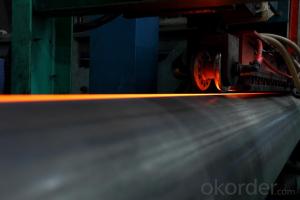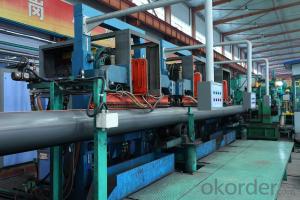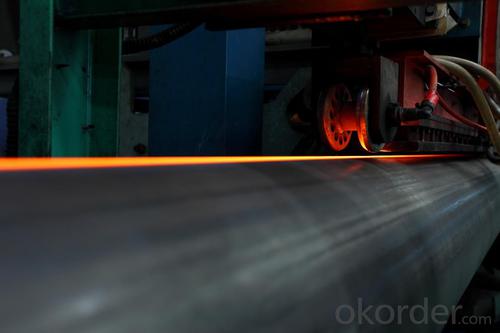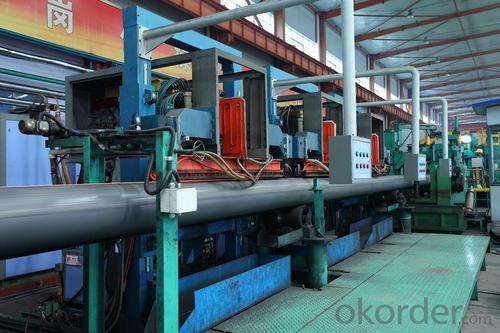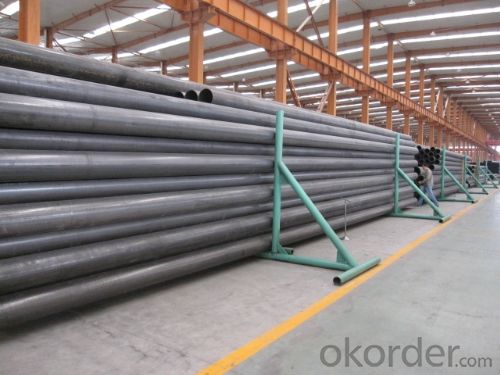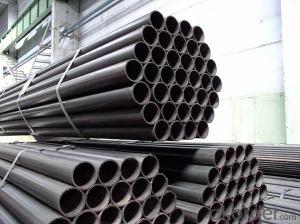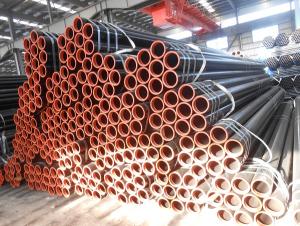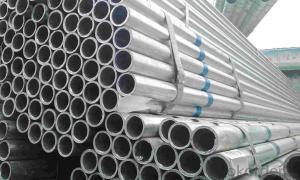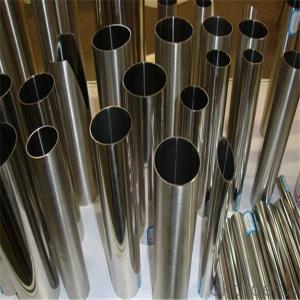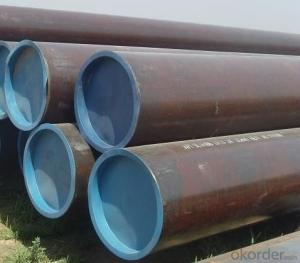Nature gas longitudinal seam steel line pipe
- Loading Port:
- China Main Port
- Payment Terms:
- TT OR LC
- Min Order Qty:
- -
- Supply Capability:
- -
OKorder Service Pledge
OKorder Financial Service
You Might Also Like
Specification
Size | OD 19mm-710mm 1/2"--28" inch | |
Thickness | 2.5-50mm | |
Executive standards | GB/TB163-2008, GB/T3087-2008, API 5L, API 5CT, ASTM A106, | |
ASTM A53, BS1387-1958 | ||
Steel grade | 10#, 20#, 20G, 35#, 45#, 16Mn(Q3458), 27SiMn, DZ50,12Cr1MoV, A106, ST52, ST45, Gr8. | |
Finish | Galvanization ,bared, oiled, black paint or as per the client's requirement,beveled edges, anti-rust oil and caps on both ends, 3PE,FBE | |
Delivery time | 10-30 days after receiving the deposit, some size is available | |
Payment item | 30% advance payment, the balance will be against the BL copy | |
LC irrevocable at sight, | ||
Marketing | South East Asia, Africa, European, South AMERICAN, USA, Australia,middle east etc. | |
Application | Structural pipe, oil or gas transportation pipe, fluid pipe, line pipe, drill pipe, boiler pipe, etc | |
Packing | PP, PE, BUNDLE, CAPS ON BOTH ENDS, AS PER THE CLIENT'S REQUIREMENT | |
Certificate | API, ISO9001 | |
Standard | BS, JIS, GB, DIN, ASTM, API | |
Port | Xingang port Tianjin China |
Dimension for thread seamless steel pipe
Chinese Standard | American Standard | German Standard | |
10# | A53-A | St37 | DIN1626 |
A106-A | St37-2 | DIN17175 | |
A179-C | St35-8 | DIN17175 | |
20# | ASTM A106-B | St45-8 | DIN17175 |
ASTM A53-B | St42-2 | DIN1626 | |
ASTM 178-C | St45-4 | DIN1629/4 | |
45# | ASTM A 1045 | CK45 |
|
16Mn | A210-C | St52 | DIN1629/3 |
St52.4 | DIN1629/4 | ||
37Mn5 | J55 | ||
- Q: Can steel pipes be used for wastewater disposal?
- Yes, steel pipes can be used for wastewater disposal. Steel pipes are commonly used in wastewater systems due to their durability, strength, and resistance to corrosion. They can handle the high pressure and flow rates often associated with wastewater and can effectively transport it to treatment plants or other disposal points. Additionally, steel pipes can be coated or lined with materials that provide extra protection against corrosion or chemical reactions with the wastewater, further increasing their longevity and effectiveness in wastewater disposal.
- Q: How much is the tube?
- The first prerequisite we need to determine is: what are the specifications of the steel pipe mentioned? Such as the commonly used steel pipe specifications: diameter 108*4.5, diameter 219*6, diameter 377*10, diameter and wall thickness of steel pipe with different specifications, different weight, so the steel price per meter is different.
- Q: Can steel pipes be used for sewage treatment plants?
- Yes, steel pipes can be used for sewage treatment plants. Steel pipes are commonly used in sewage treatment plants due to their durability, strength, and resistance to corrosion. They can efficiently transport wastewater and withstand the harsh chemical environment found in sewage treatment facilities.
- Q: How do you calculate the flow rate through a steel pipe?
- To calculate the flow rate through a steel pipe, you need to consider several factors. The most important ones are the diameter of the pipe, the pressure difference across the pipe, and the properties of the fluid flowing through it. Firstly, measure the inside diameter of the steel pipe accurately. This measurement is essential as it determines the cross-sectional area through which the fluid flows. The units for the diameter should be consistent with the units used for other measurements. Next, determine the pressure difference across the pipe. This can be done by measuring the pressure at two points along the pipe, typically at the inlet and outlet. The pressure measurements should be taken at the same height to avoid any discrepancies. The pressure difference is usually given in units of pressure (such as psi, kPa, or bar). Once you have the diameter and pressure difference, you can use the Bernoulli equation or the Darcy-Weisbach equation to calculate the flow rate. The Bernoulli equation relates the pressure difference to the velocity of the fluid. However, this equation assumes ideal conditions, neglecting factors such as friction losses, viscosity, and turbulence. The Darcy-Weisbach equation is more accurate and considers these factors. To use the Darcy-Weisbach equation, you need to know the properties of the fluid flowing through the pipe, such as its density and viscosity. These properties can be determined either through experimentation or by referring to literature values. Once you have all the necessary information, you can use the Darcy-Weisbach equation: Q = (π/4) * D^2 * √[(2 * ΔP) / (ρ * f * L)] Where: Q is the flow rate (in cubic meters per second or any other consistent units) D is the diameter of the pipe (in meters or any other consistent units) ΔP is the pressure difference across the pipe (in Pascals or any other consistent units) ρ is the density of the fluid flowing through the pipe (in kilograms per cubic meter or any other consistent units) f is the friction factor, which depends on the Reynolds number and the roughness of the pipe. L is the length of the pipe (in meters or any other consistent units) By plugging in the values for all the variables, you can calculate the flow rate through the steel pipe accurately.
- Q: What is an electric welded pipe (EFW)? Seek help!
- Pipe and pipe fittings should be suitable for the gap, usually with micro force insertion is appropriate, the gap is too large or too small will affect the quality of the interface.Check the depth of the plug and slip the spigot into the socket and position correctly.
- Q: Are steel pipes suitable for underground sewage lines?
- Yes, steel pipes are suitable for underground sewage lines. They are strong, durable, and resistant to corrosion, making them an excellent choice for sewage systems.
- Q: The outer circle of a seamless steel pipe 50 head into the outer circle of the 40 to close
- That is, according to the production process of different classification, different from hot rolling (expansion) pipe. In the process of expanding the tube or raw material tube, it is processed by multiple cold drawing, usually on single chain or double chain cold drawn machine of 0.5 ~ 100T. Cold rolled steel pipe (DIAL) in general, steel pipe for low and medium pressure boiler tube, high-pressure boiler steel pipe, alloy steel pipe, stainless steel pipe, oil cracking tube, machining pipe, thick wall pipe, small diameter and cold drawn steel tube also includes other tubes, carbon thin-walled steel, alloy thin-walled steel pipe, stainless steel pipe, special-shaped wall steel pipe. The outside diameter of cold drawn steel tube wall thickness to 6mm, to 0.25mm, to 5mm diameter thin-walled tube wall thickness is less than 0.25mm in size, accuracy and surface quality were significantly better than the hot (expanding) tube, but by the process control, its diameter and length are limited.
- Q: What is the role of steel pipe manufacturers in sustainable development?
- The role of steel pipe manufacturers in sustainable development is to promote environmental responsibility and resource efficiency throughout the production process. They play a crucial role in reducing carbon emissions by adopting cleaner technologies, optimizing energy consumption, and implementing waste management strategies. Additionally, steel pipe manufacturers can contribute to sustainable development by prioritizing the use of recycled materials, supporting recycling initiatives, and ensuring their products have a long lifespan to minimize waste generation. By embracing sustainable practices, steel pipe manufacturers can help create a more sustainable future for the construction and infrastructure industries.
- Q: Can steel pipes be used for underground fuel storage systems?
- Yes, steel pipes can be used for underground fuel storage systems. Steel pipes are commonly used in underground fuel storage systems due to their strength, durability, and resistance to corrosion. They provide a reliable and long-lasting solution for storing fuel underground, ensuring that it remains secure and protected. Steel pipes are also able to withstand the pressure and weight of the fuel, making them a suitable choice for underground storage. Additionally, steel pipes can be easily welded and interconnected, allowing for flexibility in designing and constructing underground fuel storage systems. However, it is important to ensure that the steel pipes used for underground fuel storage systems are properly coated or lined to prevent corrosion and protect the fuel from contamination. Regular inspections and maintenance are also necessary to identify and address any potential issues that may arise.
- Q: What are the different types of expansion joints used with steel pipes?
- There are several types of expansion joints used with steel pipes, including bellows expansion joints, slip expansion joints, and hinge expansion joints. Each type is designed to accommodate different types of movement and provide flexibility to the pipeline system.
Send your message to us
Nature gas longitudinal seam steel line pipe
- Loading Port:
- China Main Port
- Payment Terms:
- TT OR LC
- Min Order Qty:
- -
- Supply Capability:
- -
OKorder Service Pledge
OKorder Financial Service
Similar products
Hot products
Hot Searches
Related keywords
